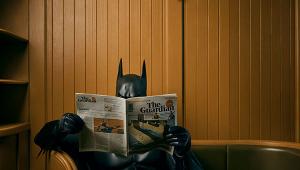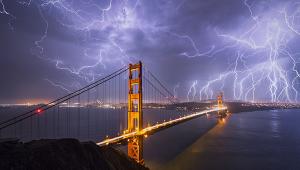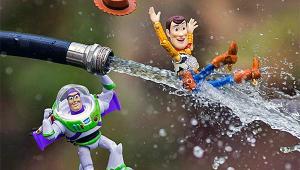Pro Talk; Peter B. Kaplan; Turn The Key
"I built my name and reputation on safety and doing things legally, with permission."
Location is everything, and Peter B. Kaplan built his career on getting to places others couldn't...or wouldn't. Although there are images taken from blimps, balloons, and helicopters, the majority of his photographs are taken from rooftops, scaffolds, antenna masts, and bridge towers and cables. The dizzying views are due to the fact that his cameras are mounted on customized poles that are extended out over the edge of whatever he's climbed.
How does he get to make the climbs and those photographs? "I know some of those guys, the ones who climb illegally," Peter says. "One of them asked me to go out with him and photograph. I said, `Stop right there. I do everything legally. I built my name and reputation on safety and doing things legally, with permission.'"
 |
|
|
Peter's photographs from the top of the north tower of the World Trade Center, taken in 1974 when construction was nearly completed, opened the door for him. "That was the right key," he says. At first he photographed from the roof; then he went higher. "I eventually got permission to photograph from the antenna. The workers would go up and down in what they called the gang box, which is raised and lowered by a crane. I was allowed to go up with them, and I spent 12 days photographing from the antenna. Once those pictures were published, I could go to city officials and building managers and bridge commissioners and tell them I was the one who did the antenna photographs from the World Trade Center, and they'd feel safe in giving me the permits." Sometimes those permits were a long time coming: it was a five-month process to get permission for the Chrysler Building. In addition to reputation and results, Peter's five million dollar liability policy was a factor.
Peter's photographed from the top of the Golden Gate Bridge, the Verrazano-Narrows Bridge, the St. Louis Arch, the Transamerica Building, the Empire State Building--literally from too many places to list. But there's one that's eluded him.
"The Eiffel Tower," Peter says. "In the mid-80s, when it was coming up to the hundredth anniversary, I wrote to the manager of the tower, the one man who could grant permission. I told him who I was, and what I'd done, especially my work photographing the Statue of Liberty. He wrote back: no. So then I spoke to a friend of mine who was married to a French senator, and she said she'd call Jacques Chirac, who was the mayor of Paris then. He was the godfather of her son. She spoke to him, I wrote to him, and he contacted the manager of the Eiffel Tower. The reply was, `I don't care who you know, the answer is still no.'
"A month or so later I got a call from the president of the Statue of Liberty/Ellis Island Foundation. He said, `Peter, I want to get some photos of the statue. The French government is giving me an award for the work I did on the statue foundation, and Francois Mitterrand is going to give me a medal.' I said, `Mitterrand? Can you do me a favor...?' He says, `Sure, I'll speak to Mitterrand for you.'
"Time passes and I get another letter from the manager of the Eiffel Tower: `I still don't care who you know, you can't have permission.' I'm sure he wondered who I was that I could get the mayor of Paris and the president of France to act on my behalf, but it didn't matter to him. He still turned me down."
The French, they are a tough key to turn.
Peter B. Kaplan is a Nikon "Legends Behind the Lens" featured photographer. The "Legends" archive can be found at www.nikonnet.com. Peter's website is www.peterbkaplan.com.
- Log in or register to post comments

















































